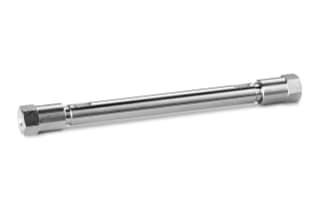
|
Separation Mode |
Ion-Exchange |
|
Maximum Pressure |
2000 psi (140 Bar) |
|
Particle Shape |
Spherical |
|
Particle Size |
7 µm |
|
Endfitting Type |
Waters |
|
Pore Size |
50 Å |
|
Format |
Column |
|
System |
HPLC |
|
USP Classification |
L17 |
|
Inner Diameter |
7.8 mm |
|
Length |
150 mm |
|
UNSPSC |
41115709 |
|
Application |
Carbohydrate |
|
Product Type |
Columns |
|
Units per Package |
1 pk |
Column, 50Å, 7 µm, 7.8 mm X 150 mm, 1/pk
Improve separation efficiency and achieve high-resolution results with the Column, 50Å, 7 µm, 7.8 mm X 150 mm, 1/pk from Waters, a high-performance reversed-phase column designed for the precise separation of a wide range of compounds.
Constructed with a silica-based material chemically modified to enhance hydrophobicity, this column delivers exceptional performance. With a pore size of 50Å and a particle size of 7 µm, it ensures efficient flow and consistent separation. Measuring 7.8 mm in diameter and 150 mm in length, each pack contains 1 piece of the lab equipment.
The Column, 50Å, 7 µm, 7.8 mm X 150 mm, 1/pk is an ideal choice for diverse applications, including liquid chromatography (LC), bioanalysis, pharmaceutical analysis, environmental analysis, and any scenario requiring the separation of a wide range of compounds. Its capability to handle complex samples with varying properties makes it a versatile tool in your analytical workflows.
By incorporating this column into your setup, you can benefit from excellent compound separation, high resolution, and reproducible results. Its optimized design ensures optimal separation efficiency, delivering accurate and reliable data for your analytical needs. The column pairs well with other Waters products, like the LCMS Certified Clear Glass 12 x 32 mm Screw Neck Vial, with Cap and Preslit PTFE/Silicone Septum, 2 mL Volume, 100/pk.
The column is compatible with various mobile phases, including water, methanol, acetonitrile, and their mixtures, offering flexibility in method development. It provides consistent and stable performance, allowing you to achieve reliable and reproducible separations in your applications.
In addition to the above, the column's silica-based material, chemically modified for hydrophobicity, ensures optimal separation performance. Its spherical particles, evenly sized for consistent flow and separation, contribute to the high-resolution results achieved. With its compatibility with various mobile phases, you have the flexibility to adapt the column to your specific separation requirements.
Order your Column, 50Å, 7 µm, 7.8 mm X 150 mm, 1/pk from Waters today and experience the difference it brings to your chromatographic separations. With its exceptional quality, reliable performance, and compatibility with a wide range of applications, this column is a valuable asset in your analytical arsenal. Trust in its capabilities to enhance your separation efficiency, deliver precise results, and advance your scientific endeavors.
What is a reversed-phase column?
A reversed-phase column is a type of chromatography column that is used to separate compounds based on their hydrophobicity. The column is packed with a material that is hydrophobic, such as silica, that has been chemically modified. The mobile phase is a mixture of water and a more polar solvent, such as methanol or acetonitrile. The more hydrophobic compounds will elute from the column first, while the more polar compounds will elute later.